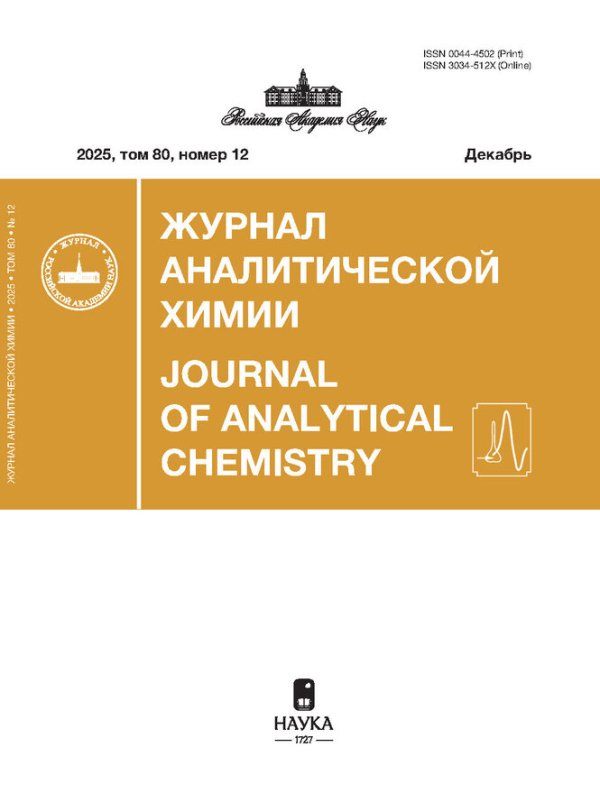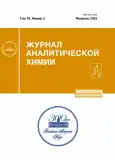Vol 78, No 2 (2023)
REVIEWS
Automation of Sample Preparation Using Principles of Chromatomembrane Separation Methods in the Analysis of Aqueous and Air Media
Abstract
A summary of the accumulated experience of using chromatomembrane methods (CMMs) for automation of the chemical analysis of water and air media is presented. Particular emphasis is placed on flow-through methods of continuous analysis, where chromatomembrane methods often have no alternative.
 99-107
99-107


Analytical Capabilities of the Determination of Carbohydrates by Chromatographic and Electrophoretic Methods
Abstract
The review discusses the advantages and limitations of chromatographic and electrophoretic approaches to the determination of neutral carbohydrates in various samples with complex matrices, the possibility of implementing a variety of liquid chromatography and capillary electrophoresis modes (in zone and micellar versions), and their combinations with various derivatization, detection, and sample preparation techniques. Conditions for the indirect detection of sugars upon the introduction of various absorbing additives into a mobile phase or supporting electrolyte, ligand-exchange capillary electrophoresis, and intracapillary complexation and the determination of carbohydrates by anion-exchange and hydrophilic chromatography are discussed.
 108-128
108-128


СТАТЬИ ОБЩЕГО ХАРАКТЕРА
Methodological Aspects of the Group Analysis of Organic Substances
Abstract
Samples of complex composition usually contain similar organic compounds, molecules of which differ in the composition and structure but are characterized by common features (structural, functional, chemical analytical, etc.), uncharacteristic for other compounds. summary concentration of similar compounds are figures of the group composition of a studied sample. Procedures for their determination are widely used in analytical control and research laboratories. A special type of chemical analysis, group analysis (GA) was developed by the end of the 20th century. Structural group analysis (SGA) is considered an important special case of GA. Unfortunately, the methodological and metrological aspects of GA and SGA have been studied insufficiently. A conventional system of terms in this field also has not been developed. This paper considers the system of terms and the history GA, principles of group formation, and methods of the assessment of summary concentration. The unresolved problems of GA are emphasized. These are the uncertainty of the qualitative composition of groups, hindering the interpretation of the results of group analysis, and also intragroup selectivity and nonadditivity of the analytical signals. Possible solutions of these problems are considered.
 129-143
129-143


ORIGINAL ARTICLES
Behavior and Fractionation of Low-Volatile Impurities in a DC Arc in the Analysis of Zirconium by Atomic Emission Spectrometry
Abstract
We studied the effect of chemically active fluorine-containing additives AlF3, BaF2, and ZnF2 on the character of evaporation of some low-volatile elements from a refractory matrix in the crater of a DC arc electrode in the analysis of zirconium by atomic emission spectrometry. The additives cause the formation of volatile fluorides of low-volatile elements and their fractional evaporation with respect to the base element evaporation. Impurity fluorides rapidly and completely evaporate during the first 30 s of arcing, and only after that the intensive evaporation of the base begins. Such fractionation increases significantly the intensity of the spectral lines of impurities, decreases the background intensity, and, consequently, improves the limits of determination of low-volatile elements in zirconium oxide. Zinc fluoride is the most effective of the studied additives. Using zinc fluoride, we lowered the limits of determination of low-volatile elements by two orders of magnitude compared to the limits of determination in zirconium oxide without additives and improved the reproducibility of the results of determinations.
 144-150
144-150


Benzofuran Spiropyrans as Analytical Reagents for Low-Molecular-Weight Aminothiols
Abstract
The problem of determining biologically active low-molecular-weight aminothiols, such as cysteine and glutathione, requires the development of new methods and analytical reagents. Among the latter substances, a group of spiropyrans can be distinguished, which are photochromic organic substances reaching an equilibrium between their cyclic and open forms in solutions. We consider a possibility of using benzofuran spiropyrans as analytical reagents for aminothiols and studied the effect of various substituents in their structure on the change in optical properties in the presence of cysteine and glutathione. An equilibrium in solutions of benzofuran spiropyrans bearing a hydroxyl group in position 7 shifts in the presence of analytes towards the formation of a colored open form. The considered spiropyrans were used to create a simple, selective, and sensitive procedure for the spectrophotometric and kinetic determination of cysteine and glutathione in vitro.
 151-158
151-158


Automated Liquid–Liquid Microextraction of Fluoroquinolones for Their Subsequent Chromatographic Determination
Abstract
An automated method is developed for dispersive liquid–liquid microextraction of fluoroquinolone antibiotics based on the principles of stepwise injection analysis. The method involves the dispersion of the extractant by the gas phase, formed in situ in the extraction chamber of the flow analyzer. A deep eutectic solvent based on a terpenoid and a mixture of hydrophilic and hydrophobic carboxylic acids is studied as an extractant for the isolation and preconcentration of fluoroquinolones, and a possibility of its use is substantiated. Hydrophilic carboxylic acid in the composition of the extractant acts as a proton donor for the formation of a carbon dioxide dispersant in the presence of sodium carbonate dissolved in the aqueous phase. A possibility of combining the developed method with high-performance liquid chromatography with fluorimetric detection is shown on an example of the determination of fluoroquinolones in wastewaters. The limits of detection (3σ) for ofloxacin, fleroxacin, and norfloxacin were 0.3 µg/L.
 159-165
159-165


Hydrolytic Stability of Unsubstituted Hydrazones of Aromatic Carbonyl Compounds in Reversed-Phase HPLC
Abstract
Unsubstituted hydrazones RR′C=NNH2 are unstable during gas chromatographic separation. Testing of their resistance to hydrolysis under reversed-phase HPLC showed that aromatic ketone hydrazones are stable. In contrast, aldehyde hydrazones are only stable in neutral methanol–water systems (in the absence of acidic modifiers). In acetonitrile–water systems containing 0.1% of formic acid, only aromatic ketone hydrazones are stable, while aldehyde derivatives are completely hydrolyzed. This difference in stability must be taken into account in determining other compounds of these classes. To detect the hydrolysis of analytes, we compared the retention indices of the initial carbonyl compounds and hydrazones at different volume ratios of organic modifiers and aqueous phases and different pH values of the eluent, the relative absorbance values of the characterized components A(254/220) = A(254)/A(220), and the chromatography–mass spectrometric data.
 166-175
166-175


Extraction and Preconcentration of the Highly Lipophilic Antioxidant 2,6-Diisobornyl-4-Methylphenol and its Metabolite from Plasma Samples for the Determination by HPLC–MS/MS
Abstract
A procedure is proposed for the extraction of 2,6-diisobornyl-4-methylphenol (IBP), the molecule with potential multi-target activity, and its active metabolite 2,6-diisobornyl-4-hydroxymethylphenol (IBP–OH) from human and rat plasma samples for further determination by liquid chromatography–tandem mass spectrometry. The solubility of IBP (in mg/mL) in various organic solvents is determined. In particular, the compound is readily soluble in chloroform (346 ± 14), methyl tert-butyl ether (98.6 ± 3.8), and ethyl acetate (96.8 ± 2.0). It is shown that the use of a mixture of chloroform and isopropanol (5 : 1, v/v) as an extraction system with simultaneous protein precipitation makes it possible to extract only 66 ± 10% of IBP, while the recovery of IBP–OH is 96 ± 7%. Pre-dilution of 200 µL of plasma with 300 µL saline increases IBP recovery to 100 ± 4%. Drying the extracts in a vacuum concentrator (air, 45°C) with the further reconstitution of the residues in 300 μL of acetonitrile facilitates the purification of biosamples and the preconcentration of analytes. The total sample preparation time does not exceed 70 min, and the duration of an analysis is 7 min, the injection volume is 2 µL. The procedure has been successfully tested on actual rat plasma samples after a single oral administration of IBP (10 mg/kg in oil) in the framework of pharmacokinetic studies.
 176-186
176-186


Chromatographic Determination of Ibuprofen in Rhodococcus Culture Media and Kinetic Modeling of Its Biodegradation Process
Abstract
The conditions for the chromatographic determination of ibuprofen in culture media of Rhodococcus spp. by reversed-phase HPLC are chosen. The specificity, linearity, and accuracy of the developed procedure are confirmed by the validation procedure, which allows its use for a reliable assessment of ibuprofen concentration in the process of bacterial degradation. With the use of kinetic modeling, a forecast is made for changes in the concentration of ibuprofen; the half-life period, the end time of the biodegradation process, and its reproducibility are determined.
 187-192
187-192













